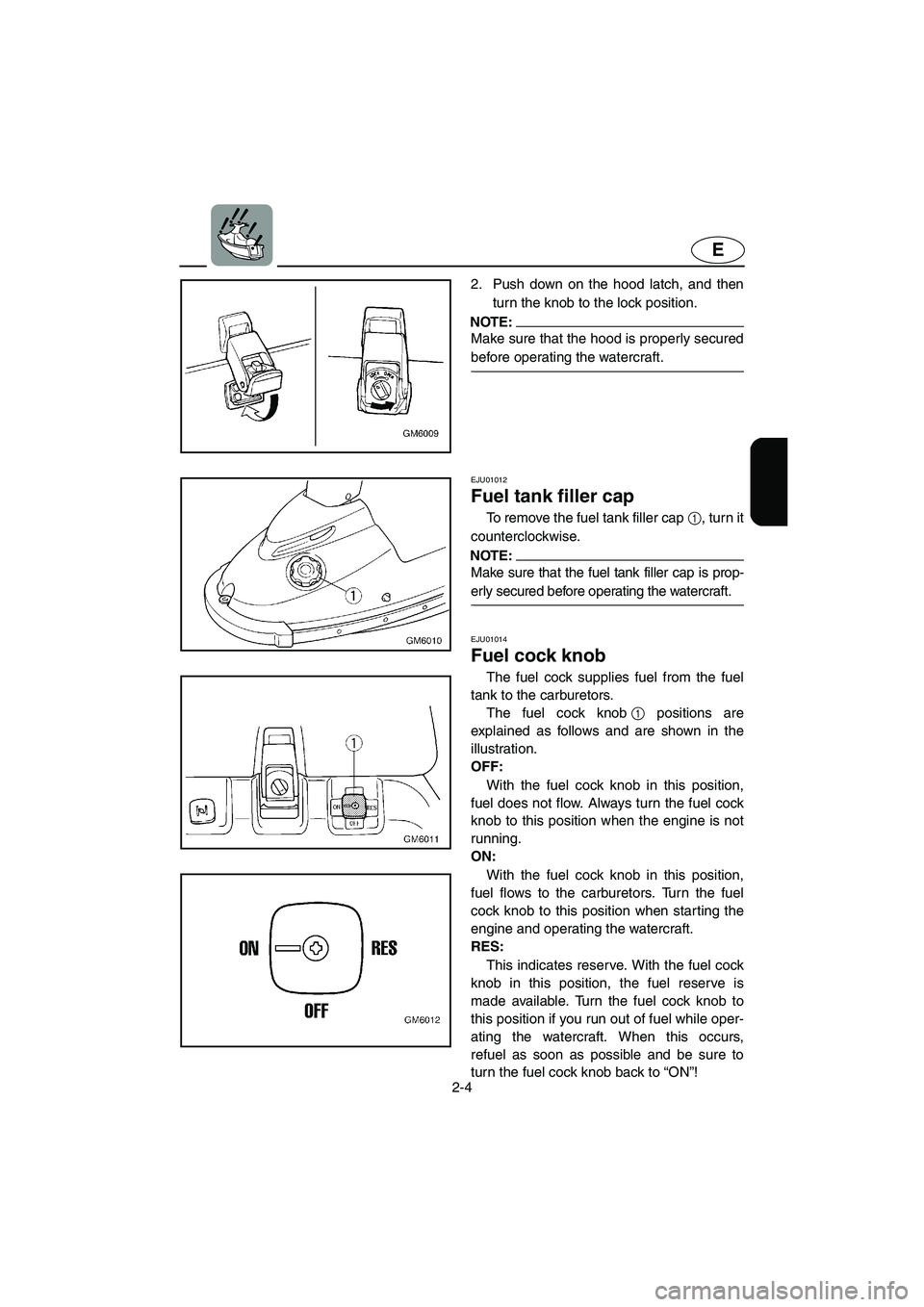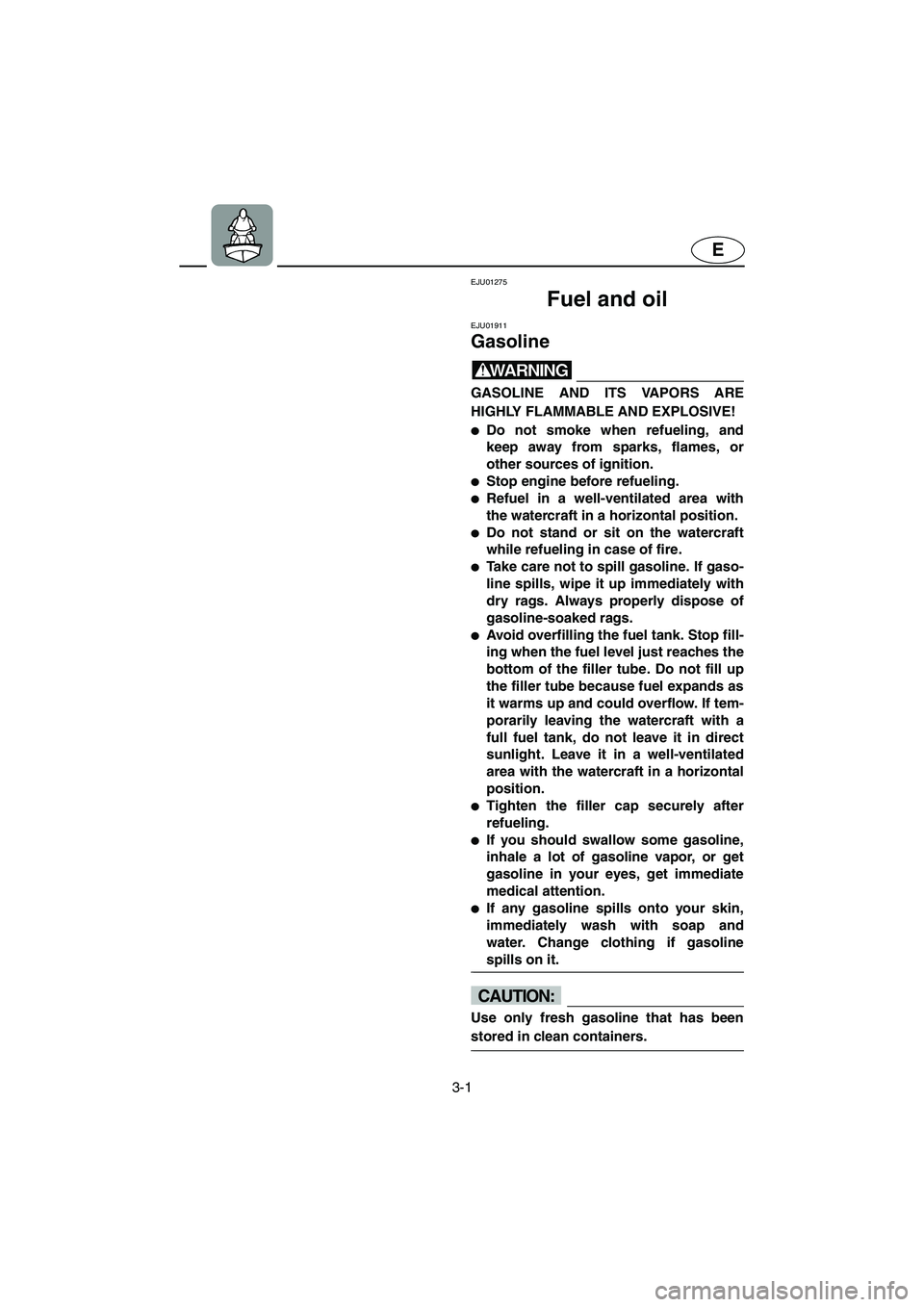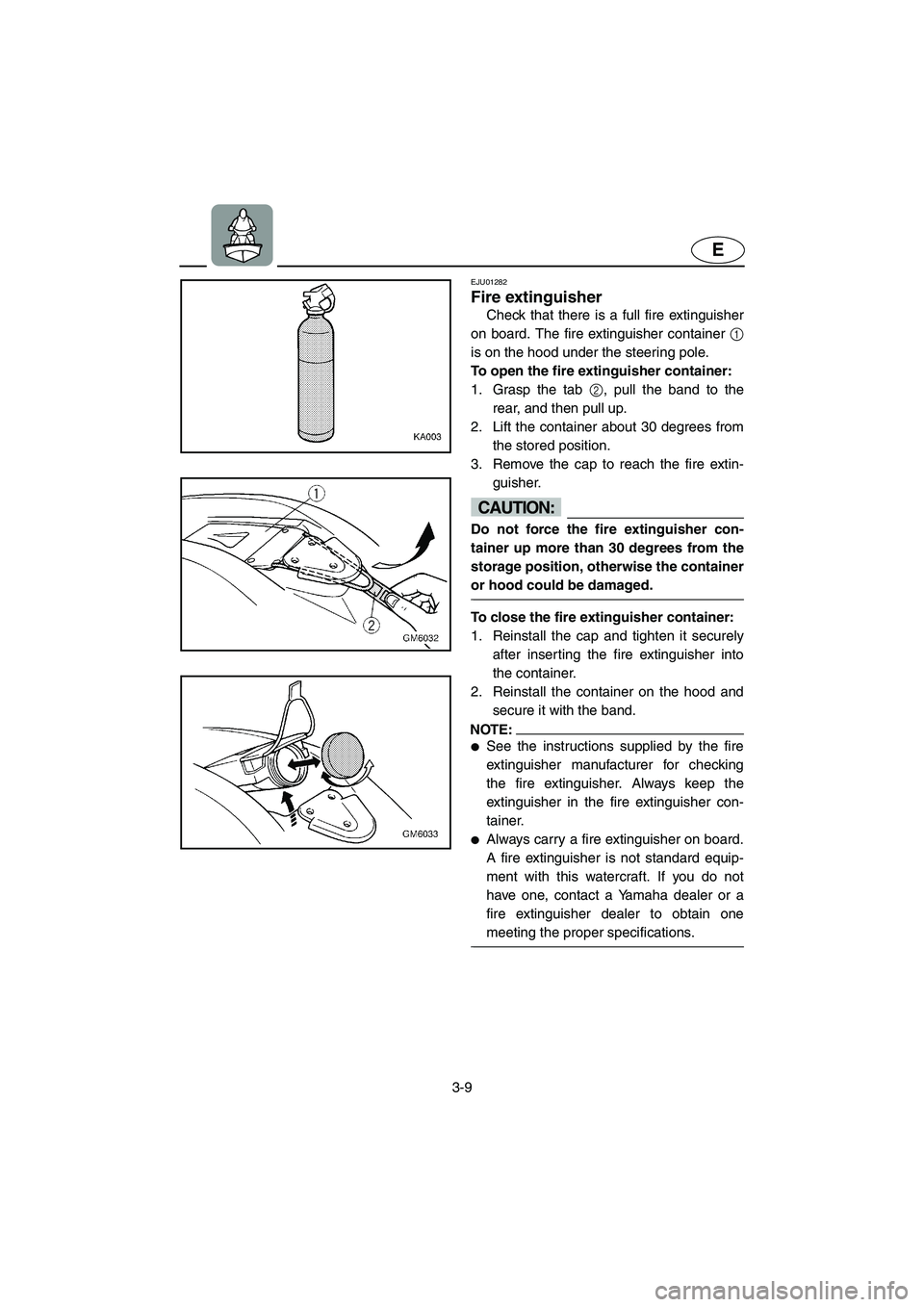Page 24 of 104
2-3
E
EJU01009
Operation of controls and
other functions
EJU01272
Hood
The hood is secured at the rear by a
latch.
Lift the steering pole and support it with
the lock pin before removing the hood.
To remove the hood:
1. Turn the latch knob 1 to the open posi-
tion, and then pull up on the hood
latch2 to unlatch the hood.
2. Grasp the hood using the handgrips 3
provided at the front and rear side of the
hood. Lift the hood up and to the rear to
remove it.
To install the hood:
1. Position the hood on the deck so the two
projections at the front of the hood fit
under the two stays on the deck.
UF1N71.book Page 3 Tuesday, June 4, 2002 3:34 PM
Page 25 of 104

2-4
E
2. Push down on the hood latch, and then
turn the knob to the lock position.
NOTE:@ Make sure that the hood is properly secured
before operating the watercraft.
@
EJU01012
Fuel tank filler cap
To remove the fuel tank filler cap 1, turn it
counterclockwise.
NOTE:@ Make sure that the fuel tank filler cap is prop-
erly secured before operating the watercraft.
@
EJU01014
Fuel cock knob
The fuel cock supplies fuel from the fuel
tank to the carburetors.
The fuel cock knob1 positions are
explained as follows and are shown in the
illustration.
OFF:
With the fuel cock knob in this position,
fuel does not flow. Always turn the fuel cock
knob to this position when the engine is not
running.
ON:
With the fuel cock knob in this position,
fuel flows to the carburetors. Turn the fuel
cock knob to this position when starting the
engine and operating the watercraft.
RES:
This indicates reserve. With the fuel cock
knob in this position, the fuel reserve is
made available. Tur n the fuel cock knob to
this position if you run out of fuel while oper-
ating the watercraft. When this occurs,
refuel as soon as possible and be sure to
turn the fuel cock knob back to “ON”!
UF1N71.book Page 4 Tuesday, June 4, 2002 3:34 PM
Page 31 of 104
2-10
E
EJU01274
Storage pouch
A storage pouch is provided on the under-
side of the hood for the Owner’s/Operator’s
Manual, tool kit and other small items.
Bend the Owner’s/Operator’s Manual
slightly to insert it into the storage pouch 1,
then add the tool kit and any other small
items. Fold the pouch and tie it with the belt.
Install the storage pouch on the hood and
secure it with the bands 2.
NOTE:@ The storage pouch is not waterproof. To
keep the contents of the storage pouch dry,
put them in a waterproof bag before putting
them in the storage pouch.
@
UF1N71.book Page 10 Tuesday, June 4, 2002 3:34 PM
Page 34 of 104

3-1
E
EJU01275
Fuel and oil
EJU01911
Gasoline
WARNING@ GASOLINE AND ITS VAPORS ARE
HIGHLY FLAMMABLE AND EXPLOSIVE!
�Do not smoke when refueling, and
keep away from sparks, flames, or
other sources of ignition.
�Stop engine before refueling.
�Refuel in a well-ventilated area with
the watercraft in a horizontal position.
�Do not stand or sit on the watercraft
while refueling in case of fire.
�Take care not to spill gasoline. If gaso-
line spills, wipe it up immediately with
dry rags. Always properly dispose of
gasoline-soaked rags.
�Avoid overfilling the fuel tank. Stop fill-
ing when the fuel level just reaches the
bottom of the filler tube. Do not fill up
the filler tube because fuel expands as
it warms up and could overflow. If tem-
porarily leaving the watercraft with a
full fuel tank, do not leave it in direct
sunlight. Leave it in a well-ventilated
area with the watercraft in a horizontal
position.
�Tighten the filler cap securely after
refueling.
�If you should swallow some gasoline,
inhale a lot of gasoline vapor, or get
gasoline in your eyes, get immediate
medical attention.
�If any gasoline spills onto your skin,
immediately wash with soap and
water. Change clothing if gasoline
spills on it.
@
CAUTION:@ Use only fresh gasoline that has been
stored in clean containers.
@
UF1N71.book Page 1 Tuesday, June 4, 2002 3:34 PM
Page 38 of 104

3-5
E
EJU01346
Pre-operation checks
EJU01347
Pre-operation check list
Before operating this watercraft, perform the checks in the following check list. See the
accompanying text in this chapter for details on how to perform the checks.
WARNING@ If any item in the pre-operation check list is not working properly, have it inspected
and repaired before operating the watercraft, otherwise an accident could occur.
@
NOTE:@ Pre-operation checks should be made thoroughly each time the watercraft is used. This pro-
cedure can be completed in a short time. It is worth the time spent to assure safety and reli-
ability.
@
ITEM ROUTINE PAGE
Engine compar tment Remove hood, ventilate fuel vapors and check
electrical connections3-6
Bilge Check for water and fuel residue and remove if
necessary3-7
Throttle Check that throttle lever springs back 3-10
Steering system Check for proper steering system operation 3-10
Fuel Check fuel level and add if necessary
Check hoses and tank for leakage3-6
Water separator Check for water and drain if necessary 3-7
Battery Check electrolyte level and battery condition 3-8
Hood Check that hood latches are secured 2-3
Hull/Deck Check hull for cracks or other damage—
Jet unit Check for debris and remove if necessary 3-11
Fire extinguisher Check condition and replace if necessary 3-9
Engine shut-off cord Check condition and replace if frayed or broken 3-11
Switches Check start switch, engine stop switch and
engine shut-off switch for proper operation when
watercraft is in the water 3-12
Cooling water pilot outlet Check that water is discharged while engine is
running and watercraft is in the water3-12
UF1N71.book Page 5 Tuesday, June 4, 2002 3:34 PM
Page 39 of 104

3-6
E
EJU01048
Pre-operation check points
EJU01278
Engine compartment
Ventilate the engine compartment, before
each use. To ventilate the engine compart-
ment, lift the steering pole and support it
with the stopper pin, then remove the hood.
Put the hood aside for a few minutes to allow
any fuel vapors to escape. Also, check for
loose electrical connections.
WARNING@ Failure to ventilate the engine compart-
ment could result in fire or explosion. Do
not start the engine if there is a fuel leak
or loose electrical connection.
@
EJU01279
Fuel system
Check the fuel system for leakage, cracks
or malfunctions before each use. (See
page 4-10 for check points and correct pro-
cedures.)
1. Remove the fuel tank filler cap to release
any pressure that might have built up in
the fuel tank.
2. Remove the hood, and then check the
fuel level in the tank. Replenish if neces-
sary. (See page 3-4 for filling instruc-
tions.)
3. Close the fuel tank filler cap securely.
UF1N71.book Page 6 Tuesday, June 4, 2002 3:34 PM
Page 41 of 104
3-8
E
EJU01054
Battery
Check the battery condition and the elec-
trolyte level.
Check that the battery leads are tightened
securely and there is no corrosion on the
battery terminals.
WARNING@ The battery must always be fully charged
and in good condition. Loss of battery
power may leave you stranded. Never
operate the watercraft if the battery does
not have sufficient power to start the
engine or if it shows any other signs of
decreased power.
@
Make sure that the breather hose is prop-
erly connected and that it is not damaged or
obstructed.
Make sure that the battery is securely
held in place.
1
Positive (+): Red lead
2
Negative (–): Black lead
3
Breather hose
UF1N71.book Page 8 Tuesday, June 4, 2002 3:34 PM
Page 42 of 104

3-9
E
EJU01282
Fire extinguisher
Check that there is a full fire extinguisher
on board. The fire extinguisher container 1
is on the hood under the steering pole.
To open the fire extinguisher container:
1. Grasp the tab 2, pull the band to the
rear, and then pull up.
2. Lift the container about 30 degrees from
the stored position.
3. Remove the cap to reach the fire extin-
guisher.
CAUTION:@ Do not force the fire extinguisher con-
tainer up more than 30 degrees from the
storage position, otherwise the container
or hood could be damaged.
@
To close the fire extinguisher container:
1. Reinstall the cap and tighten it securely
after inserting the fire extinguisher into
the container.
2. Reinstall the container on the hood and
secure it with the band.
NOTE:@ �See the instructions supplied by the fire
extinguisher manufacturer for checking
the fire extinguisher. Always keep the
extinguisher in the fire extinguisher con-
tainer.
�Always carry a fire extinguisher on board.
A fire extinguisher is not standard equip-
ment with this watercraft. If you do not
have one, contact a Yamaha dealer or a
fire extinguisher dealer to obtain one
meeting the proper specifications.
@
UF1N71.book Page 9 Tuesday, June 4, 2002 3:34 PM